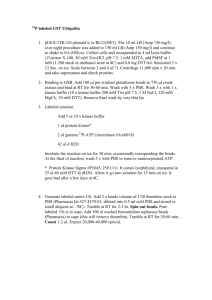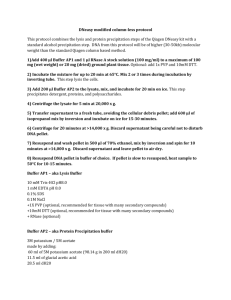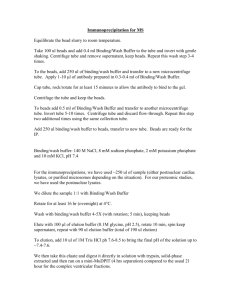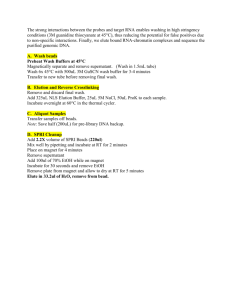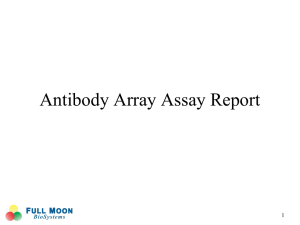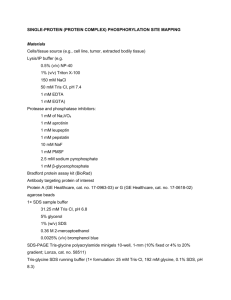Media:Daniel_ChromatinImmunoprecipitation_Protocol
advertisement
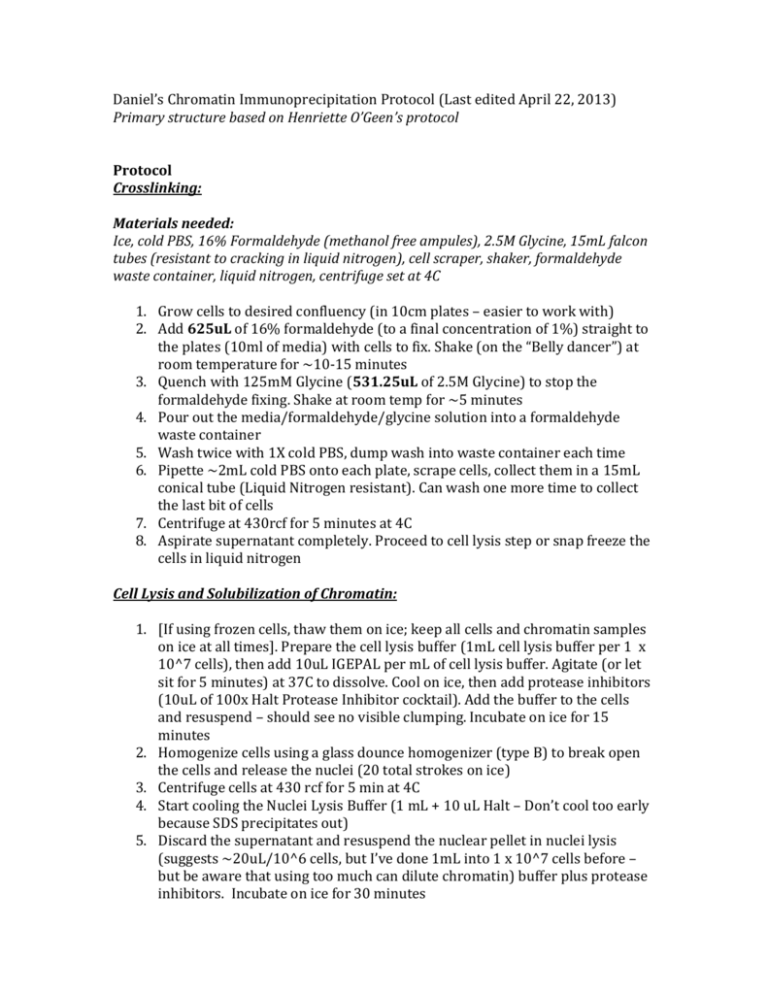
Daniel’s Chromatin Immunoprecipitation Protocol (Last edited April 22, 2013) Primary structure based on Henriette O’Geen’s protocol Protocol Crosslinking: Materials needed: Ice, cold PBS, 16% Formaldehyde (methanol free ampules), 2.5M Glycine, 15mL falcon tubes (resistant to cracking in liquid nitrogen), cell scraper, shaker, formaldehyde waste container, liquid nitrogen, centrifuge set at 4C 1. Grow cells to desired confluency (in 10cm plates – easier to work with) 2. Add 625uL of 16% formaldehyde (to a final concentration of 1%) straight to the plates (10ml of media) with cells to fix. Shake (on the “Belly dancer”) at room temperature for ~10-15 minutes 3. Quench with 125mM Glycine (531.25uL of 2.5M Glycine) to stop the formaldehyde fixing. Shake at room temp for ~5 minutes 4. Pour out the media/formaldehyde/glycine solution into a formaldehyde waste container 5. Wash twice with 1X cold PBS, dump wash into waste container each time 6. Pipette ~2mL cold PBS onto each plate, scrape cells, collect them in a 15mL conical tube (Liquid Nitrogen resistant). Can wash one more time to collect the last bit of cells 7. Centrifuge at 430rcf for 5 minutes at 4C 8. Aspirate supernatant completely. Proceed to cell lysis step or snap freeze the cells in liquid nitrogen Cell Lysis and Solubilization of Chromatin: 1. [If using frozen cells, thaw them on ice; keep all cells and chromatin samples on ice at all times]. Prepare the cell lysis buffer (1mL cell lysis buffer per 1 x 10^7 cells), then add 10uL IGEPAL per mL of cell lysis buffer. Agitate (or let sit for 5 minutes) at 37C to dissolve. Cool on ice, then add protease inhibitors (10uL of 100x Halt Protease Inhibitor cocktail). Add the buffer to the cells and resuspend – should see no visible clumping. Incubate on ice for 15 minutes 2. Homogenize cells using a glass dounce homogenizer (type B) to break open the cells and release the nuclei (20 total strokes on ice) 3. Centrifuge cells at 430 rcf for 5 min at 4C 4. Start cooling the Nuclei Lysis Buffer (1 mL + 10 uL Halt – Don’t cool too early because SDS precipitates out) 5. Discard the supernatant and resuspend the nuclear pellet in nuclei lysis (suggests ~20uL/10^6 cells, but I’ve done 1mL into 1 x 10^7 cells before – but be aware that using too much can dilute chromatin) buffer plus protease inhibitors. Incubate on ice for 30 minutes 6. Optional: Flash-freeze the cells to help break open the nuclei more efficiently (critical if we skip the homogenizing). After incubation of nuclei in NL buffer for 30 minutes, flash freeze samples in liquid nitrogen, thaw at room temperature (once thawed, transfer to ice; do not allow samples to warm up to room temp), and proceed to sonication. 7. Sonicate using the Diagenode Biorupter to achieve an average chromatin length of 150-500bp (sonication time varies depending on cell type, lysis buffer, etc. – will need to be optimized). *I also use Diagenode’s “TPX” tubes – shears with greater efficiency 8. Centrifuge at 10,000 rcf for 10 minutes at 4C. Carefully transfer the supernatant (sonicated chromatin) to new tubes while making sure to avoid the cell debris. Keep sonicated chromatin on ice (4C) while performing quantification and determining shearing efficiency *I typically flash-freeze the remaining chromatin after I pool them, and removed 20ul [or equivalent to 100,000 – 200,000 cells] for analysis 9. Take an aliquot of chromatin sample and add ChIP elution buffer to a total volume of 100 uL then 12uL of 5M NaCl to give a final salt concentration of 0.54M. Boil samples in water bath for 20 minutes to reverse crosslinks 10. Allow samples to cool, add 1uL DNase-Free RNase (10mg/ml) and incubate for 20 minutes at 37C. 11. Purify DNA (Ampure XP beads), elute in 28uL. Measure chromatin concentration by NanoDrop. Calculate chromatin yield 12. Run remaining chromatin on a 2% agarose gel (I use GeneRuler 50bp as my ladder, run for 1 hour at 110V) to visualize average chromatin size Chromatin Immunoprecipitation 1. Save 10% Input (or volume corresponding to 500 ng of chromatin). Store at – 20C (or I keep it at 4C until the next day when used) 2. Dilute chromatin fivefold with ice-cold IP Dilution buffer (1 vol. chromatin and 4 vol. IP Dilution buffer – e.g. 200uL chromatin and 800uL IP Dilution buffer) containing protease inhibitors. *For histone marks covering a small portion of the genome displaying sharp peaks (i.e. H3K4me3, we typically use 1 ug chromatin. For spreading histone marks (i.e. H3K9me3 or H3K36me3) that cover large portions of the genome, we use 5 ug of chromatin. 3. Preclear step: Wash beads 2x with IP dilution buffer (with more than or equal vol of beads), and resuspend the beads in equal volume after 2 washes – I generally take 60ul per antibody (20ul for preclear, 40ul for binding) 4. Add 20ul of the washed beads into the extract chromatin, rotate for at least 2 hrs at 4C 5. Remove beads from extract with magnet, and transfer to tubes with your antibody (typically use 1 to 5 ug of antibody – this is variable dependent on antibody). Keep track of the catalogue number and lot number of the antibodies used 6. Incubate 8-16 hours (O/N) on a rotating platform at the 4C Next day: 1. Add 40uL magnetic protein G beads to each ChIP sample ranging from 1 to 5ug chromatin starting material and incubate on rotating platform for at least 2 hours at 4C 2. At room temperature, allow beads to settle for 1 minute on a magnet separation rack. Carefully remove the supernatant and don’t disturb the beads. The rest of the wash steps are done at room temp. 3. Wash the beads TWO times with IP Dilution buffer. Onto a rotator for 5 minutes each time to resuspend and wash 4. Wash beads TWO times with IP Wash Buffer 2. Remove supernatant entirely between washes. Be careful not to cross contaminate other samples 5. Wash once with the higher stringency IP Wash Buffer 3. Discard all wash solutions 6. Elute antibody/chromatin complexes by adding 100 uL elution buffer per ChIP sample. Shake samples on a vortexer for 30 minutes (heated vortexer preferred – set at 65C) Remember, do the same for the “Input” sample. Add 80uL of ChIP elution buffer to the input sample to get up to 100uL total 7. After 30 minutes of heated vortexing, allow beads to settle onto the magnet. Carefully transfer the supernatant containing the antibody/chromatin complexes to a siliconized tube 8. Add 12 uL of 5M NaCl per 100uL elution buffer mix to give a final concentration of 0.54M NaCl (including the input sample) 9. Incubate all samples in a 67C water bath overnight to reverse formaldehyde crosslinks DNA Purification 1. Allow samples to cool off from the 67C water bath. Add 1uL of RNase A (10mg/ml). Incubate at 37C for 20-30 minutes 2. Purify DNA using the Agencourt Ampure XP beads. Elute each sample with 30uL of EB buffer (10mM Tris) 3. Proceed on to quantification (NanoDrop or Qubit), and downstream steps (i.e. library synthesis and sequencing) Materials and Buffers 1. Thermo Scientific 100X Halt Protease Inhibitor cocktail 2. Cell Lysis Buffer (Store at room temp): 5mM PIPES pH 8, 85mM KCl. Add igepal (NP-40) fresh each time to give a final concentration of 1% (10 ul/ml). Warm buffer in 37C water bath and vortex briefly to mix. After mixing, place buffer with igepal on ice to cool and then add your protease inhibitors 3. Nuclei Lysis Buffer (Store at room temp): 50mM Tris-HCl pH8, 10mM EDTA, 1% (w/v) SDS. Place buffer on ice right before use to avoid precipitation of SDS and add protease inhibitors just prior to use 4. Elution Buffer (Store at room temp): 50mM NaHCO3, 1% (w/v) SDS 5. DNase-free RNase A (Fermentas; 10mg/ml) 6. Agencourt Ampure XP DNA purification beads (and magnet) 7. Nanodrop or Qubit for quantification of double-stranded DNA samples 8. IP Dilution Buffer (Store at 4C): 50mM Tris-HCl pH 7.4, 150mM NaCl, 1% (v/v) igepal, 0.25% (w/v) deoxycholic acid, 1mM EDTA pH 8. Add protease inhibitors just prior to use. This buffer is used to adjust the salt and SDS concentrations for the immune-precipitation step 9. Magnetic protein G beads (e.g. Dynabeads) 10. IP Wash Buffer 1 (Store at 4C): Same as IP Dilution Buffer, but without protease inhibitors 11. IP Wash Buffer 2 (Store at room temp): 100mM Tris-HCl pH 9, 500mM LiCl, 150mM NaCl, 1% (v/v) igepal, 1% (w/v) deoxycholic acid 12. Elution Buffer (Store at room temp): 50mM NaHCO3, 1%(w/v) SDS 13. 5M NaCl (autoclaved) *Filter sterilized most of the buffers listed References O’Geen, H, Echipare, L, Farnham, PJ (2011). Using ChIP-seq Technology to Generate High-Resolution Profiles of Histone Modifications. Methods in Molecular Biology


